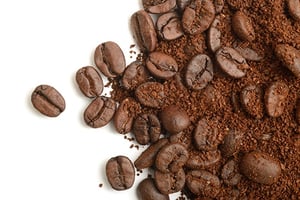For many cappuccino and latte lovers, the ideal coffee coupling consists of a warm microfoam meticulously mingled with a favorite coffee. And, a seemingly magical dose of microfoam is at the crux of latte art for coffee aficionados. But, can foam and coffee work together to remedy water pollution problems? A new study reveals how coffee and foam can function in concert to divorce destructive chemicals, such as  mercury, from polluted water.
mercury, from polluted water.
The study, published in ACS Sustainable Chemistry & Engineering, explained how researchers from the American Chemical Society used spent coffee grounds and bioelastomeric foam to remediate water. The foam, infused with expended coffee grounds, performed as a filter. Water is deemed remediated when pollutants are eliminated so it is safely consumable for people to drink.
Since 2000, scientists have recognized that coffee has the ability to detach heavy metals from water. Coffee grounds have uncharged or negatively charged amine, carboxylic and phenolic groups. Once the positively charged heavy metals are diffused in water they adhere to the coffee. The residual metals linger after the polluted water proceeds through the grounds.
“By adding sugar and silicone to coffee, the researchers were able to make a foamy brick that held together on its own and was easy to use as a filter. Soaking the brick in water caused the sugar to leach out and leave the coffee grounds open to bind to metal ions in the water.”
Results from the study showed that during the 30 hours of the filtration procedure, a coffee-infused foam brick the size of a postage stamp disconnected 99 percent of the mercury content from tainted water. This water remediation solution is eco-friendly and cost-effective. The filtration process is simple and fast, and the filter can be disposed of after it has been used.
One of the most popular commodities in the world, coffee is a second favorite only to oil. The coffee industry is worth $100 billion globally.
But what to do with the lingering coffee ground waste?
Six million tons of exhausted coffee grounds are produced each year. Expended coffee grounds are routinely used for fertilizer and can be modified into biodiesel. Nevertheless, many of the coffee grounds from kitchens, restaurants, or offices still wind up in landfills.
Besides remediating hazardous substances from water, coffee grounds have also proven their pliability when it comes to reusing them. Recently, coffee has been celebrated for its health-promoting antioxidants, especially a collection of antioxidants identified as phenolic compounds. Coffee grounds are packed with the same beneficial antioxidants.
In 2015, The Journal of Agricultural and Food Chemistry researchers discovered how to mine the antioxidants from the coffee grounds. They also strived to find out how intense coffee ground antioxidants can be. The researchers found that sometimes the grounds had higher levels of the phenols than the coffee did. Consequently, researchers have postulated that the grounds have the ability to boost the nutritional benefits of other foods when the grounds are used as an additive.
Because coffee grounds can improve soil quality by introducing nitrogen and potassium, and increasing magnesium levels, grounds can be used as a fertilizer for plants and gardens and are capable of defusing soil acidity.
Mercury analyzers are an important element used in laboratories today. There are a variety of applications where Mercury instruments are best suited. For more information on these analyzers and how they can help with your mercury analysis needs, please contact us or visit our website
Be sure to read our Technical Note demonstrating how the Hydra IIC Mercury Analyzer can be used to detect mercury levels in coffee grounds.

